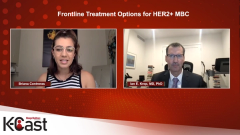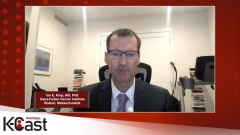
COVID-19 and the Use of HER2-Targeted Therapy for MBC
The impact of the COVID-19 pandemic on the utilization of newer targeted therapies for HER2-positive metastatic breast cancer and considerations regarding their adoption into clinical practice based on the availability of vaccines.
Episodes in this series

Briana Contreras: I have a couple of questions that will be highlighting the ways in which the availability of HER2-targeted therapy has required adaptations to clinical practice. For my first question, how do you incorporate patient preference in treatment selection?
Ian E. Krop, MD, PhD: I think we touched on that a little before. The advantage of having multiple options now for HER2-directed therapies is that we can tailor our therapies for individual patients. We certainly take into account things, as I mentioned, like hair loss. There are regimens like T-DM1 [trastuzumab emtansine] and the HER2CLIMB regimen, which don’t cause any significant alopecia; and we use those if patients are averse to losing their hair. Drugs like trastuzumab deruxtecan cause hair loss in about half of patients. Those are some of the considerations; also whether patients are able to travel to your infusion center easily, or an every-3-week infusion drug versus a weekly drug. There are big medical issues, like brain metastases, which I think would steer us more toward drugs like tucatinib-based treatment. Other inpatients who don’t have brain metastases can use this very effective agent trastuzumab deruxtecan, which has about a 97% disease control rate. Those are the medical issues, layering on top of patient preferences. The good thing is we have lots of options; most patients are going to get all of these drugs at one point or another, and it’s a matter of sequence.
Briana Contreras: How have you changed your practice to accommodate patients on targeted therapy in terms of patient care, and what are some of the challenges that may have come about?
Ian E. Krop, MD, PhD: In the COVID-19 era, those kinds of practical issues have to be thought of even more than in the past. There is not a big difference between giving an infusion of trastuzumab versus an infusion of vinorelbine, or chemotherapy versus targeted therapy. In other words, there’s not a huge difference in terms of practical infusion issues. Particularly during the COVID-19 pandemic, we’ve been trying to minimize the number of visits patients have to have; using longer-acting therapies is helpful there. We’ve been trying to avoid using immunosuppressive regimens; that’s a reason to try to avoid immunosuppressive chemotherapy for patients, especially when COVID-19 was flaring in each of our areas. Those are some of the things we’ve been thinking about to try to make it easier for patients, cutting down visits, avoiding immunosuppression. I think those are the main things. The other issue is some of these are oral regimens, meaning you need to have nurses be able to call patients to make sure they’re taking the drugs appropriately at home, and they’re not having real problems managing things like diarrhea or mucositis. It helps to have more outreach to patients now that they’re taking more medications at home versus getting infusions in the infusion room.
Briana Contreras: As you mentioned the pandemic, did your use of HER2-targeted therapies for patients with metastatic breast cancer change during the COVID-19 pandemic, and if so, how? Do you think these changes will continue now that the COVID-19 vaccines are available?
Ian E. Krop, MD, PhD: Yes, particularly when COVID-19 was really surging, we did our best to try to minimize the number of trips patients had to make, and used therapies that only required once-every-3-week visits or therapies that patients could take largely at home. There has been a push to try to use fewer infusions. There’s an interest in subcutaneous formulations of antibodies, which we now have with trastuzumab and pertuzumab. That’s been helpful because it means that if they have to come in [to the infusion room], it can be for a short time. There are people who are investigating whether you can get these drugs at home as subcutaneous formulations, and have nurses go to people’s homes to give them their subcutaneous injection, so they don’t have to come in at all. That’s going to require a whole new set of infrastructure if it scales, but it’s worth thinking about that. COVID-19 gave us a nudge that we needed to try to explore some of those things. Whether they’ll prove to be cost-effective and feasible for everybody post–COVID-19, we’ll have to find out. But it certainly made us think creatively, and we’ll probably come up with some kind of happy medium where we’re requiring patients to come in fewer times, and for shorter amounts of time, as much as possible.
Briana Contreras: Thank you so much, Dr. Krop, for your time. This has been an excellent discussion, and we hope you found the information to be valuable to your clinical practice. Thank you all for watching this Managed Healthcare Executive® K-Cast program from MJH Studios®.
Transcript edited for clarity.
Newsletter
Get the latest industry news, event updates, and more from Managed healthcare Executive.






























































